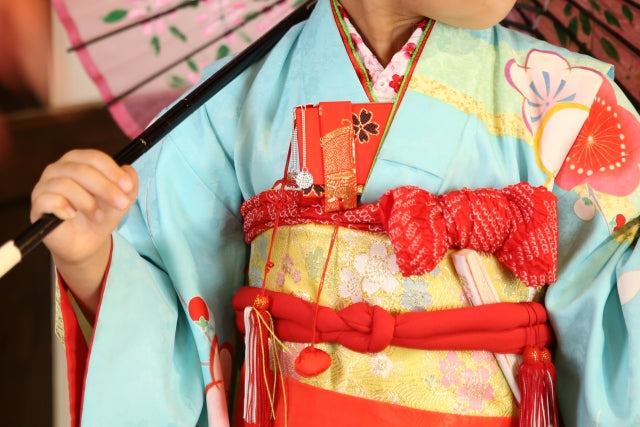
Japanese Life Milestone Celebrations: Shichi-Go-San, and Other Traditions
Among various Japanese traditional ceremonies to celebrate the growth and life milestones of children, Shichi-Go-San stands out as the most outstanding. Originating in the Heian period, Shichi-Go-San is a festival thanking and appreciating the healthy development of children, realizing the further growth of the child. This article will explain the origins of these Shichi-Go-San and related events, and also how to blend in the furoshiki, which is a conventional Japanese wrapping fabric for this particular occasion.
Origins and Meaning of Shichi-Go-San
It is trailed back from ceremonies marking stages of growth at age 3, 5, and 7 in Heian times: Shichi-Go-San.
-
Kamioki (Age 3): In the Heian period, unfortunately, babies had to have shaved heads at seven days old and grew up this way-shaven-headed-until such time as the age of 3. Then from that age, the children would be allowed to grow their hair, celebrated by the kamioki ceremony, in honor of the growth.
-
Hakamagi: This was the age when boys would, for the first time, put on a ceremonial hakama in the hakamagi ceremony and became full-fledged members of society. Thus, Shichi-Go-San is usually celebrated at this age by boys.
-
Obitoki: At 7 years of age, girls began to graduate from a sash, often called "string belt," to a formal obi, or broad sash.
These gained in popularity among the samurai and the merchant classes during the Edo period, a time which eventually spread down to all classes in the Meiji period, thereby developing into the Shichi-Go-San festival we have today.
Meaning of "Kami no Ko" by Child of the Gods
Until modern medicine was advanced, reaching the age of 7 was regarded as a milestone; before that time, the mortality rate for children was high. In former times, children were called "kami no ko" until the age of 7, in gratitude and respect for their life. So accordingly, Shichi-Go-San is an important expression about gratitude and expectation for children's health in their families.
Why November 15?
Traditionally, Shichi-Go-San falls on November 15, that the Tokugawa shogunate chose as Kijuku-nichi-the day ogres stay indoors-and thus was the most auspicious day of the calendar. Nowadays, it's celebrated over the nearest holiday or weekend to the date, or any time that one finds convenient to get the family together.
Growth milestones beyond Shichi-Go-San
Apart from the Shichi-Go-San, Japan has plenty of traditional events for marking growth milestones in the life of a child:
- Oshichiya (7th Day): Naming ceremony seven days after birth.
- Omiyamairi: Day 30 First shrine visit to pray for health.
- Okuizome: A meal at the 100th day after birth in order to treat the child with foods so that it will never feel hungry.
- Half-Birthday: Celebration of the child's birthday every six months.
- Hatsuzekku: First Seasonal Festival, celebrated on 3rd of March for girls and 5th of May for boys.
- First Birthday: Celebrates the child's first year.
Additional Growth Milestone Celebrations
- 10-Year Celebration: It always happens in March to celebrate yet another milestone in the life of children who reach ten years.
- Coming of Age Ceremony: Normally done in a school setting for 10 year olds who reflect on things to come.
- Jusan Mairi: At the age of 13 years, a visit to a shrine for receiving blessings of wisdom.
To Our Overseas Readers: How does your culture celebrate growth milestones?
In Japan, various events of the family to mark their lives are also held at these temples and shrines. Events like Shichi-Go-San depict the growth of every child. We would love to hear similar traditions in your country. For example, is there a special birthday or coming of age celebration? Although the culture may be quite different, the sharing of life's milestones is very important to the family. Please feel free to share your family traditions!
Including the Furoshiki in Shichi-Go-San Celebrations
Modern Shichi-Go-San celebrations bring the family together for shrine blessings, photo opportunities, and festive meals. The furoshiki adds an elegant touch of traditional Japanese times to such moments. Furoshiki wrapping includes a beautiful and highly versatile cloth with deep meaning, symbolizing "wrapping," "protecting," and "binding together." Here are some ideas for incorporating furoshiki:
-
Furoshiki Wrapping: Putting gifts inside a furoshiki is a graceful and respectful wrapping; for such a time, it gives additional beauty to the traditional moment of giving a gift.
-
Symbol of Growth and Connection: Furoshiki can "wrap," "protect," and "connect" things, and because of that, furoshiki is really symbolic of growth and family bonding. You wish someone connection and care in a deeper sense with a furoshiki gift.
Those ceremonies of Shichi-Go-San and others in Japan mark the growth of children, family, and appreciation. The events for social cohesion and genuine hopes that form for a child's life come with great humility. The fact that it is wrapped in furoshiki, a symbol of Japanese culture, gives such moments even more weight. We quite look forward to learning about your family's traditions and celebrating universally around growing together across cultures.
